What Is Data Warehouse Architecture & How To Design It?
A well-designed data warehouse is the backbone of a successful business strategy. But what exactly is a data warehouse architecture, and how do you go about designing one that meets your specific needs?
This guide by SkillTrans will demystify the concept, outline the different types of architectures, and walk you through a step-by-step approach to designing your own data warehouse architecture.
What Is Data Warehouse Architecture?
According to Wikipedia, a data warehouse is defined as follows:
“In computing, a data warehouse (DW or DWH), also known as an enterprise data warehouse (EDW), is a system used for reporting and data analysis and is considered a core component of business intelligence. Data warehouses are central repositories of integrated data from one or more disparate sources. They store current and historical data in one single place that are used for creating reports. This is beneficial for companies as it enables them to interrogate and draw insights from their data and make decisions.”
Thus, the definition of data warehouse architecture can be stated as follows:
Data warehouse architecture is the structural and organizational framework that defines how a data warehouse system stores, processes, and manages data to support business intelligence, analytics, and reporting. It encompasses the various components, technologies, and processes involved in the design, development, and maintenance of a data warehouse.
3 Types of Data Warehouse Architectures
Data warehouse architectures vary in complexity and scalability to meet the needs of organizations with different data volumes and processing requirements.
The 3 main types of Data Warehouse Architecture are:
Single-Tier Architecture
In this simple architecture, all components of the data warehouse (the database, data staging area, and query tools) reside on a single server.
Advantages:
Cost-effective: Requires minimal hardware investment.
Ease of implementation: Simple to set up and manage.
Disadvantages:
Limited scalability: Not suitable for handling large volumes of data or complex queries.
Performance bottlenecks: All processes compete for the same resources, potentially slowing down performance.
Ideal Use Cases: Small businesses or departments with limited data storage and processing needs.
Single-tier architecture diagram example: (Source: Scaler)
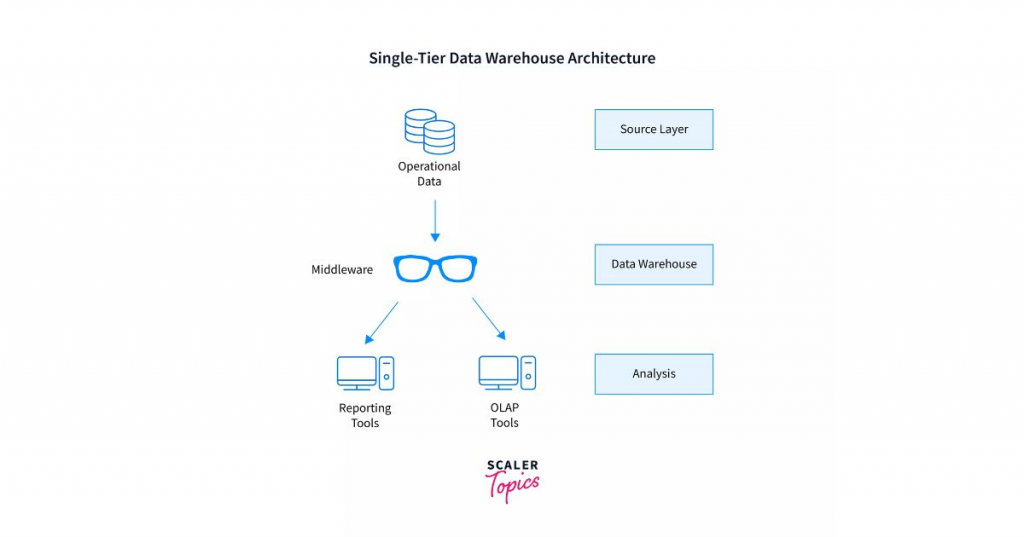
Two-Tier Architecture
The two-tier architecture separates the data warehouse database (the back-end) from the Online Analytical Processing (OLAP) engine (the front-end). These components reside on different servers.
Advantages:
Improved performance: Distributing the workload across two servers reduces the strain on individual resources.
Enhanced scalability: Allows for easier expansion by adding more servers as data volumes grow.
Disadvantages:
Higher initial cost: Requires additional hardware investment compared to the single-tier architecture.
Increased complexity: More components mean more potential points of failure and increased management overhead.
Ideal Use Cases: Medium-sized organizations or departments with moderate data processing needs and a desire for better performance.
Two-tier architecture diagram example: (Source: phoenixNap)
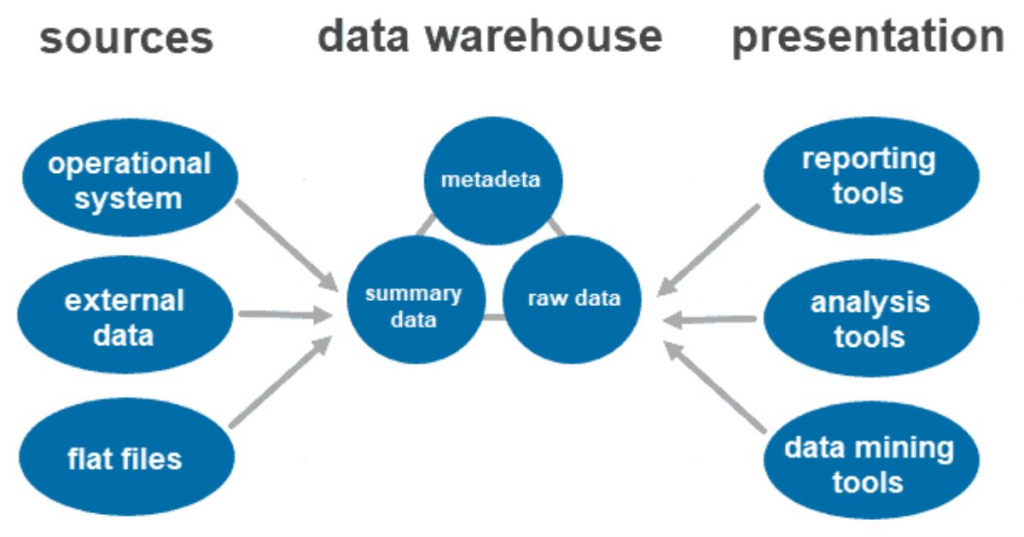
Three-Tier Architecture
The three-tier architecture introduces a middle tier between the database and the OLAP engine. This middle tier is responsible for data staging, processing, and transformation.
Advantages:
Scalability: The most scalable architecture, easily accommodating growing data volumes and complex processing requirements.
Flexibility: The middle tier can be customized with specialized tools and processes for specific data transformation needs.
High performance: Each tier focuses on specific tasks, leading to optimal resource utilization and faster query response times.
Disadvantages:
Increased complexity: The most complex architecture, requiring specialized knowledge and resources for implementation and maintenance.
Higher cost: Involves the highest initial investment due to the need for more hardware and software.
Ideal Use Cases: Large enterprises with massive data volumes, complex analytical requirements, and a need for high performance and scalability.
Three-tier architecture diagram example: (Source: Educba)
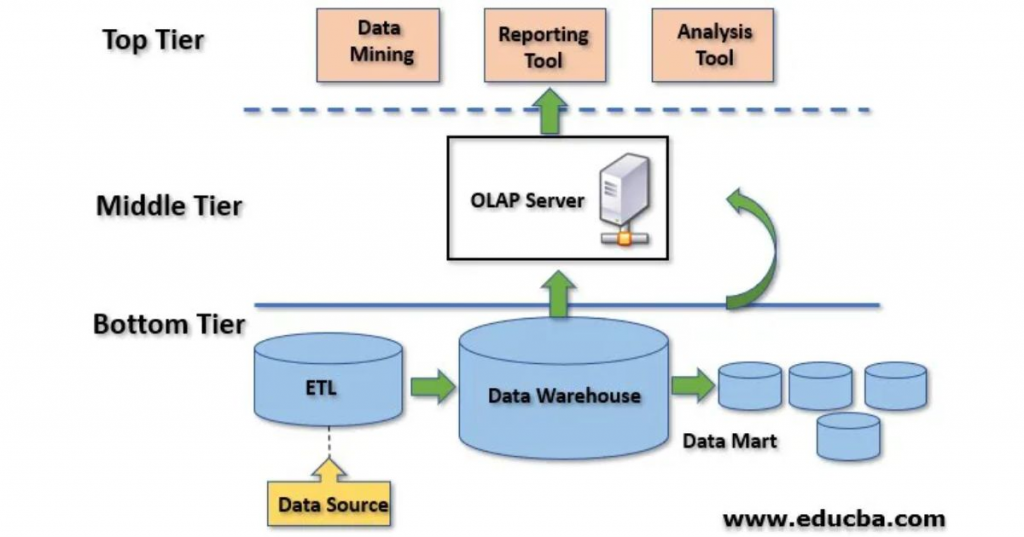
Other Data Warehouse Architecture Models
There are several models of data warehousing architecture, each with its own advantages and ideal use cases. In addition to the single-tier, two-tier, and three-tier architectures we discussed, here are some other important models:
Virtual Data Warehouse
A virtual data warehouse doesn't physically store data. Instead, it acts as a logical layer that integrates data from multiple disparate sources on demand. Queries are federated across the different sources, and the results are presented as if they came from a single warehouse.
Advantages:
Cost-effective: Eliminates the need for a separate physical data warehouse, reducing storage and maintenance costs.
Flexibility: Easily adapts to changes in data sources or requirements.
Disadvantages:
Performance limitations: Query performance can be slower due to the need to access multiple data sources.
Complexity: Requires sophisticated tools and expertise to manage the integration and federation of data.
Ideal Use Cases: Organizations with diverse data sources that want to quickly gain insights without investing in a physical data warehouse.
Virtual Data Warehouse architecture diagram example: (Source: ResearchGate)
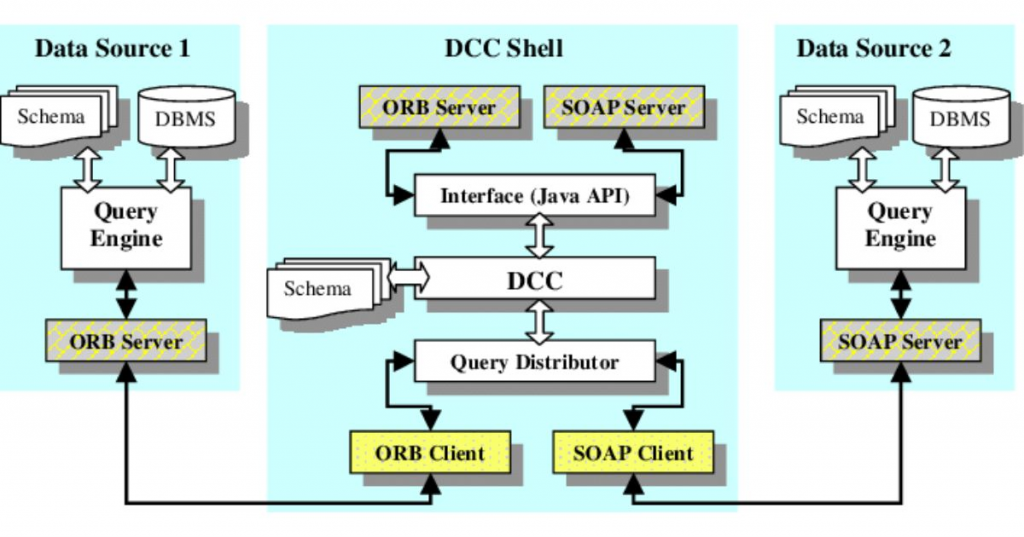
Data Mart
A data mart is a subset of a data warehouse focused on a specific subject area or department (e.g., sales, marketing, finance). It contains a summarized or aggregated version of data relevant to that particular area.
Advantages:
Targeted access: Provides focused access to data relevant to specific business needs.
Faster query performance: Smaller size and specialized focus lead to faster query response times.
Easier management: Simpler to develop and maintain than a full-fledged data warehouse.
Disadvantages:
Limited scope: Only addresses the needs of a specific area, not the entire organization.
Data redundancy: This may lead to some data duplication if not carefully integrated with other data marts or the data warehouse.
Ideal Use Cases: Organizations with specific departmental needs and a desire for quick access to relevant data.
Data Mart architecture diagram example: (Source: Wikipedia)
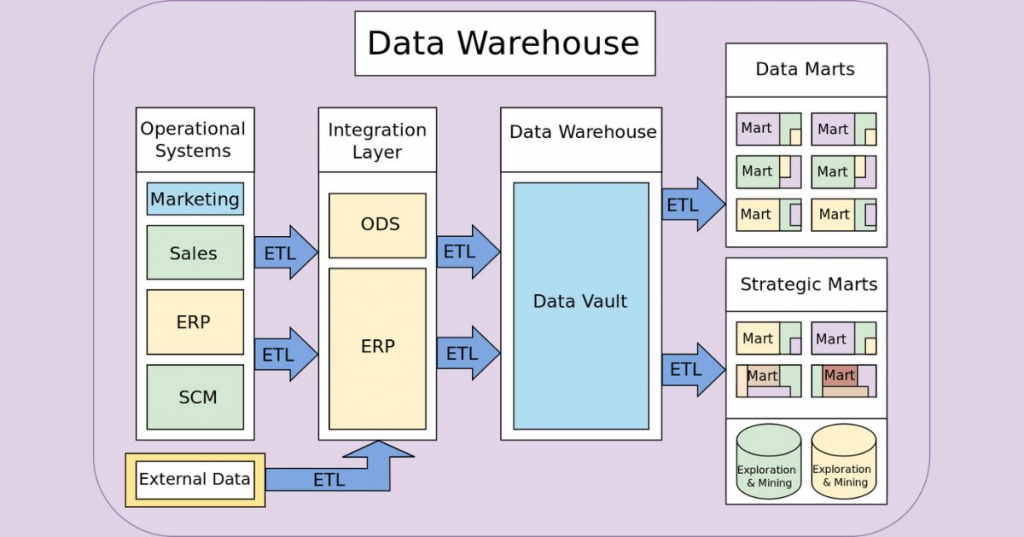
Enterprise Data Warehouse (EDW)
An EDW is a centralized repository that integrates data from all operational systems and external sources across the entire organization. It provides a single version of the truth for all decision-making processes.
Advantages:
Comprehensive view: Offers a complete and unified view of all enterprise data.
Enhanced decision-making: Facilitates informed decision-making based on accurate and consistent data.
Data consistency: Ensures data integrity and eliminates inconsistencies across departments.
Disadvantages:
Complexity: Highly complex to design, implement, and maintain.
Costly: Requires significant investment in hardware, software, and resources.
Ideal Use Cases: Large organizations with complex data environments and a need for centralized data governance and decision-making.
Enterprise Data Warehouse (EDW) architecture diagram example: (Source: AltexSoft)
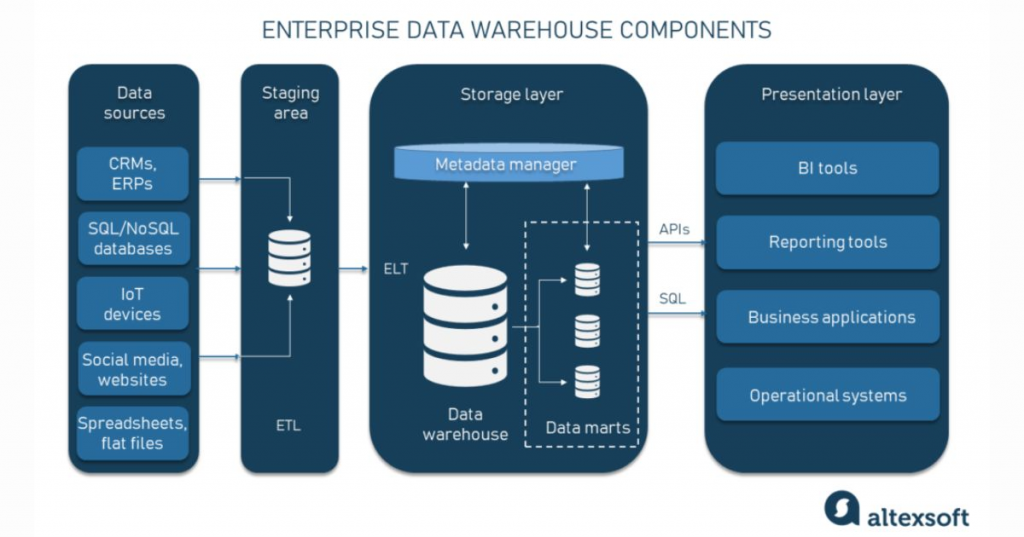
Operational Data Store (ODS)
An ODS is a database designed to integrate data from multiple source systems in real-time or near real-time. It's often used as an interim staging area for data before it's loaded into a data warehouse.
Advantages:
Real-time data: Provides access to current data for operational reporting and decision-making.
Data consolidation: Integrates data from disparate sources for a unified view.
Disadvantages:
Limited historical data: Typically doesn't store large amounts of historical data.
Performance impact: Real-time updates can affect the performance of source systems.
Ideal Use Cases: Organizations that need real-time data for operational reporting and analysis.
Operational Data Store (ODS) architecture diagram example: (Source: DataZoomers)
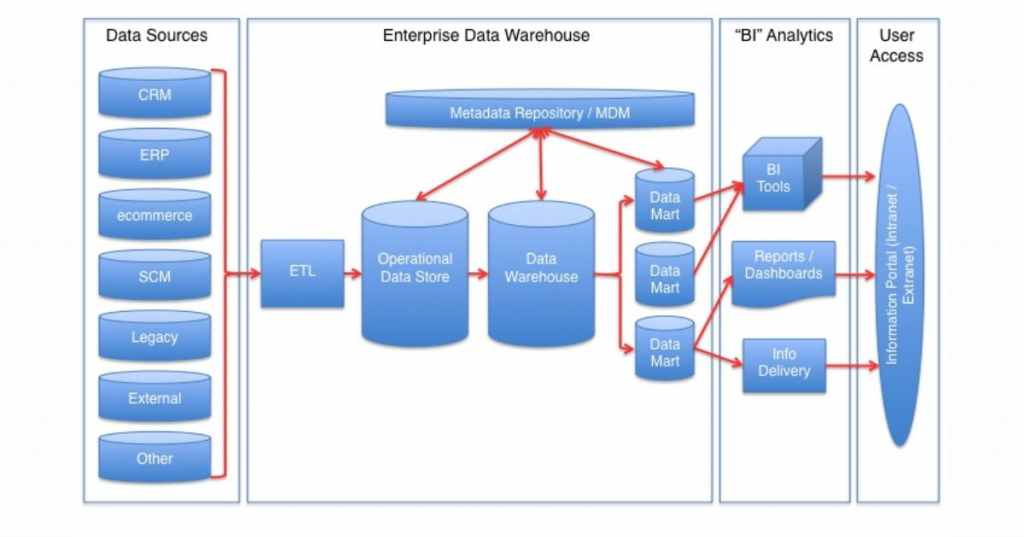
How To Design Data Warehouse?
Here's a simplified step-by-step guide on how to design a data warehouse. Also, we'll enhance the step-by-step guide with examples for each stage of the data warehouse design process:
(To go into more detail, perhaps we will have to discuss more in another article)
Define Business Requirements
Identify stakeholders: Engage with business users, analysts, and IT personnel to understand their needs and expectations.
Gather requirements: Clearly define the business questions the data warehouse should answer, the types of reports and analyses needed, and the desired performance and scalability.
Prioritize objectives: Determine the key business drivers and prioritize the data and functionalities that align with those objectives.
Example: A retail company wants to analyze sales trends across different regions, product categories, and time periods. They need a data warehouse to track sales data, inventory levels, and customer demographics.
Conceptual Data Modeling
Create a conceptual data model: Design a high-level model representing the key business entities, their relationships, and the attributes relevant to the analysis.
Validate with stakeholders: Ensure the model accurately reflects the business understanding and addresses the identified requirements.
Refine the model: Iterate on the conceptual model based on feedback and further analysis.
Example: The conceptual data model for the retail company might include entities like "Customer," "Product," "Store," "Sales Transaction," with relationships like "Customer buys Product at Store."
Logical Data Modeling
Develop a logical data model: Translate the conceptual model into a detailed logical model defining the tables, columns, data types, and relationships within the data warehouse.
Normalize or denormalize: Choose the appropriate level of normalization based on query performance requirements and data redundancy considerations.
Define data granularity: Determine the level of detail at which data will be stored (e.g., daily, weekly, monthly).
Example: The logical data model translates these entities into tables (e.g., Customers, Products, Stores, Sales), defines columns (e.g., Customer ID, Product Name, Store Location, Sales Amount), and specifies data types (e.g., integer, string, date).
Physical Data Modeling
Design the physical data model: Specify the physical storage structures, indexing, partitioning, and other optimizations based on the target database technology.
Consider hardware and software: Choose the appropriate hardware and software platforms to support the desired performance and scalability.
Example: For a large dataset, the physical model might partition the Sales table by month to optimize query performance. The choice of database could be PostgreSQL for its flexibility and cost-effectiveness.
ETL Process Design
Extract, Transform, Load (ETL): Design the processes for extracting data from source systems, transforming it into a consistent format, and loading it into the data warehouse.
Data cleansing: Implement data quality checks and cleansing processes to ensure data accuracy and completeness.
Data integration: Resolve data conflicts and inconsistencies from different source systems.
Example: The ETL process could extract daily sales data from the point-of-sale system, transform it by aggregating sales by product category, and load it into the data warehouse. Data cleansing might involve removing duplicate records and correcting invalid customer addresses.
Choose a Data Warehouse Architecture
Select the appropriate architecture: Based on the requirements, choose between single-tier, two-tier, three-tier, virtual data warehouse, or other models.
Consider scalability: Ensure the chosen architecture can accommodate future growth in data volumes and complexity.
Example: Given the large volume of sales data and the need for complex analysis, the retail company might choose a three-tier architecture to ensure scalability and performance.
Front-End Design
Develop the user interface: Create user-friendly interfaces for accessing and analyzing data, such as reporting tools, dashboards, and ad-hoc query interfaces.
Implement security measures: Ensure appropriate security controls are in place to protect sensitive data.
Example: The retail company's analysts could use a business intelligence tool like Tableau to create dashboards visualizing sales trends, or they might use SQL to perform ad-hoc queries against the data warehouse.
Testing and Deployment
Test thoroughly: Conduct comprehensive testing of the data warehouse, ETL processes, and front-end interfaces to identify and resolve any issues.
Deploy in phases: Implement the data warehouse in stages, starting with a pilot and gradually expanding to the full scope.
Example: Before full deployment, the data warehouse could be tested with a subset of historical sales data to validate the ETL process and the accuracy of the loaded data.
Monitoring and Maintenance
Establish monitoring processes: Monitor the performance, data quality, and usage patterns of the data warehouse to identify and address any problems.
Implement maintenance procedures: Develop a plan for ongoing maintenance and updates to keep the data warehouse aligned with changing business needs.
Example: The IT team could set up alerts to monitor the data warehouse for errors in the ETL process, such as failed data loads or data inconsistencies. They might also schedule regular maintenance tasks to optimize database performance.
Key Points In How To Design Data Warehouse
Data warehouse design is a collaborative effort involving both business and technical stakeholders.
Each step in the design process builds upon the previous one, ensuring that the final data warehouse aligns with the organization's needs.
It's important to be flexible and adaptable throughout the process, as requirements may change and new challenges may arise.
Conclusion
Data warehouse architecture is the foundation for effective data analysis and decision making. Through understanding different models and using tools like diagrams, you can design a data warehouse that fits your organization's needs. A well-designed data warehouse allows you to turn raw data into valuable insights.
If you are looking for knowledge and tips about data warehouse, then don't hesitate to visit SkillTrans's Online Learning Catalog where you will find many free and premium courses to help you master this essential skill.

Meet Hoang Duyen, an experienced SEO Specialist with a proven track record in driving organic growth and boosting online visibility. She has honed her skills in keyword research, on-page optimization, and technical SEO. Her expertise lies in crafting data-driven strategies that not only improve search engine rankings but also deliver tangible results for businesses.



